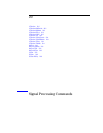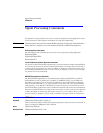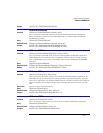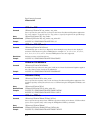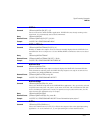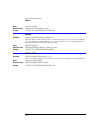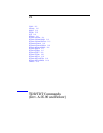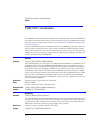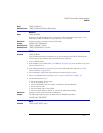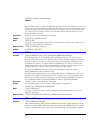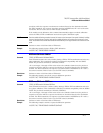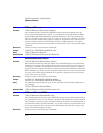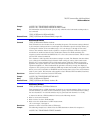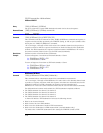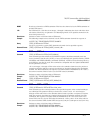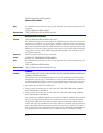
21-3
TDR/TDT Commands (Rev. A.05.00 and Below)
NVALid?
Query :TDR{2 | 4}:HPOLarity?
Returned Format [:TDR{2 | 4}:HPOLarity] {POSitive | NEGative}<NL>
NVALid?
Query :TDR{2 | 4}:NVALid?
Queries the specified TDR module to determine if valid normalization data exists. A 1 is
returned, if a valid normalization exists. Otherwise, a 0 is returned.
Restrictions Software revision A.04.20 and A.05.00. TDR mode.
Example 10 OUTPUT 707;":TDR2:NVALid?"
Returned Format [:TDR{2 | 4}:NVALid] {1 | 0}<NL>
Returned Format [:TDR{2 | 4}:RESPonse<N>] {1 | 0}<NL>
PRESet
Command :TDR{2 | 4}:PRESet
This command performs an automatic set up of the instrument for TDR or TDT measure-
ments, based on the stimulus. This command does the following:
• Turn on TDR channels.
• If the stimulus is set to EXT ernal ( see “STIMulus” on page 21-10), turn off channel 1 or 3 and
turn on channel 2 or 4.
• If the TDT destinations are not shown, turn on the TDT destination channels. (see “RE-
SPonse:TDTDest” on page 21-8).
• Set the timebase to 500 ps/div and positions the incident edge on screen.
• Turn on averaging and set best flatness (see “Acquire Commands” in chapter 6).
• For all channels that are on:
• Set the attenuation units to ratio.
• Set the attenuation to 1:1.
• Set the bandwidth to low (12.4 GHz). (Set high for external stimulus.)
• Set the units to volts.
• Set the channel scale to 100 mV/div.
• Set the channel offset to 200 mV or –200 mV for differential stimulus.
Restrictions Software revision A.05.00 and below. TDR mode.
Example The following example presets the instrument for TDR/TDT operations.
10 OUTPUT 707;":TDR2:PRESET"
RATE
Command :TDR{2 | 4}:RATE {AUTO | <rate>}



